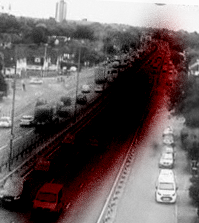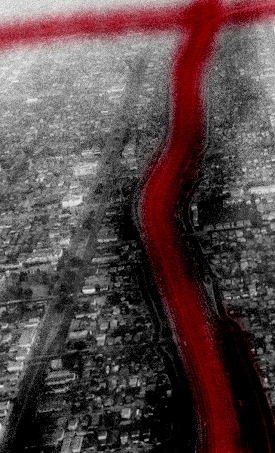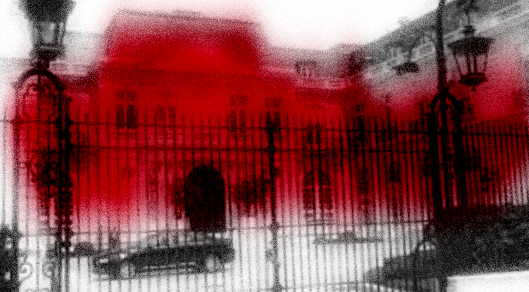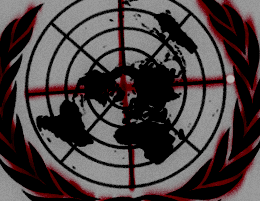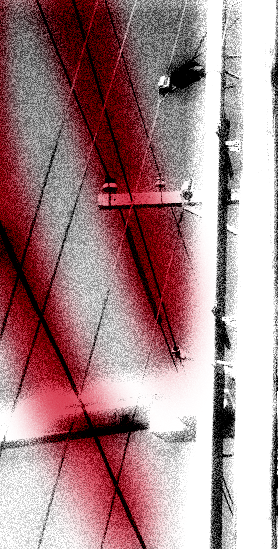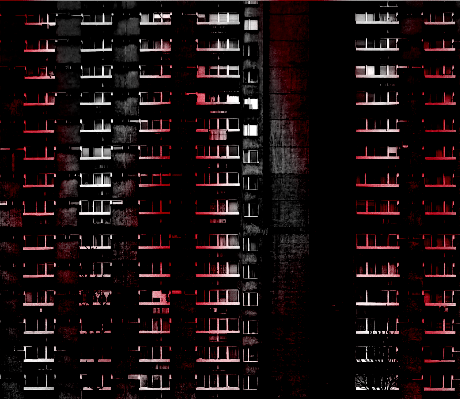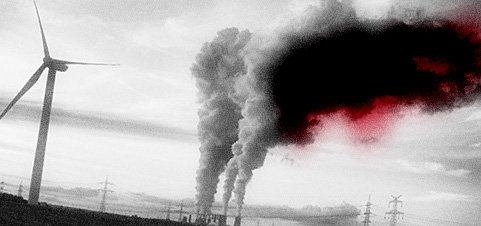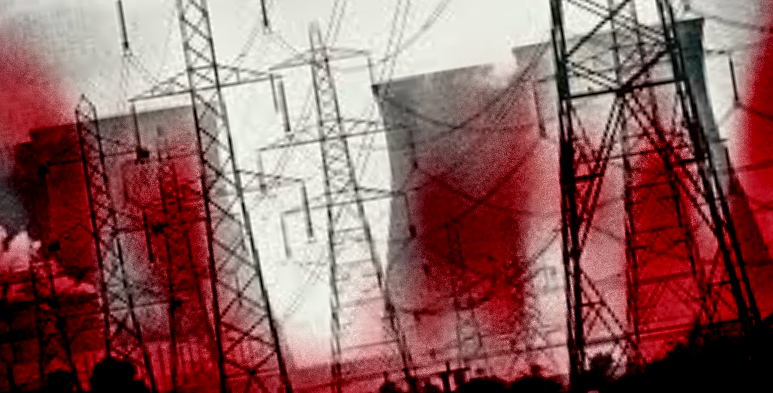by Paul Cudenec
[This is the text of a talk I gave at the “Three Days Against Techno-Sciences” gathering near Alessandria, Italy, on Saturday July 30, 2022. Many thanks to the organisers and fellow participants for the warm welcome and the stimulating exchanges. A post-recorded audio version can be found here.]
The so-called Great Reset is nothing but the extension and violent acceleration of a longstanding process.
Over the decades, I have often despaired at the general apathy of my fellow citizens in the face of the dark forces which I could clearly see – and feel – gathering.
Wondering how we could ever hope to see a mass uprising against the dominant system, I sometimes comforted myself with the thought that one day “they” would become so arrogant, or impatient, that they would push things too far, beyond the limits of what humankind is collectively prepared to tolerate.
What we have been experiencing for the last two years could well be that moment, so that the Great Reset would prove to be not just the extension of the existing process, but its culmination, the hubris which announces its final demise, its nemesis.
So what is this “process” I am talking about? There are lots of different ways of describing it. It is the increase of centralising power, the tightening of control, the growth of “the economy”, the ever-closer convergence of power and money.
Today I want to focus on one concept which I think is key to understanding the essence of this process, namely “development”.
The term, in English, is a very broad and ambiguous one, which allows it to be seriously misused and manipulated.
Sometimes it is used in the intransitive context to refer to something that happens by itself, from the inside, like the development of a child’s abilities or character as it grows into an adult, the development of somebody’s understanding or the development of a particular culture.
In this sense, it carries the implications of being natural and positive – resonances which serve to disguise the quite different qualities of other applications of the same word.
Development used in a transitive sense refers to actions taken from the outside to develop a certain thing.
It could refer to what I am doing right now – the development of an idea or an argument. This kind of development is the act of organising various elements (information, personal experience, opinions) in order to create something which is (hopefully!) coherent and useful.
Again, this sense carries positive implications which can be used to camouflage the reality behind other processes with the same semantic label.
In terms of the historical process I referred to, development could broadly be applied to the industrialisation which began in the country of my birth in the 18th century and subsequently spread across what we term the West.
Here we can immediately see how the other meanings of the word “development” obscure our understanding of the industrial variety.
The first, intransitive, association can lead us into imagining that industry was something that “developed” organically, all by itself, as the unfolding of a natural socio-economic evolution.
And the second, transitive, association could make us assume that industrial development was a positive process of using our collective intelligence to organise something useful for society.
Conventional opinion within industrial society usually amounts to a combination of these two, faulty, interpretations: people tend to imagine that the natural evolution of our collective intelligence leads us to organise this inevitable and ongoing development.
Continuous industrial development has been the background to all our lives, but it is not necessarily something of which we are always conscious.
For me, the form in which it first became visible and real was that of what in England is called “property development”, namely the building of houses, shops and factories on what was previously “undeveloped” land.
My first encounter with this phenomenon was when I was about ten years old and living on the very southern edge of the London conurbation.
One summer day I discovered, with some schoolfriends, what seemed to me like an amazing paradise – a meadow, ringed with trees, with a tiny stream running through the middle of it, over which we leapt time and time again, tumbling and laughing into the lush green grass.
Some time later I went back there to taste again that moment of pure happiness and discovered that somebody had left mysterious piles of large concrete pipes in our field.
Being children, we didn’t care too much, had no idea what all this meant, and happily spent the afternoon clambering around, and through, these pipes.
But the second time I went back, the field was a housing estate and there was no more grass, no more stream, no more playing.
A few years later, my mother bought, as a present for an elderly friend, a book of photographs of the local area dating from the beginning of the 20th century, when this lady was a girl.
Glancing through the images, I noticed that one of them apparently showed a road that I knew well. But I couldn’t believe it was the same place.
In the photograph was a simple country lane, surrounded on all sides by trees, along which a man was leading a horse and cart.
The road that I knew in the 1970s, although still called a “lane”, was lined with identical 1930s houses along its whole length and was intersected by one of the busiest traffic routes out of London.
Suddenly I understood why older people had always referred to the local suburban shopping parade as “the village”. It really had been a village when they first knew it!
How could everything have changed so quickly, within the living memory of people I personally knew?
I could never see the area in which I had always lived in the same way again and later chose to live and work outside of London, in Sussex, where I discovered villages and country lanes which no longer existed in the area where I grew up.
For a long time I was happy there. I felt I was breathing an air which had been denied me for too long.
But, of course, I wasn’t safe from the advance of development, whose principal requirement is that it must never slow down, let alone stop.
All around me were appearing new housing developments, new roads to serve the houses, more new houses to fill the spaces opened up by the new roads, new shopping precincts to serve the people living in the houses and more new roads to take them there.
Both in my work as a journalist on a local newspaper and in my parallel role as a campaigner trying to protect the countryside, I came to understand the mechanisms by which this development came to happen.
The first thing I observed was that there was always local opposition to any proposed development on a greenfield area – the bigger the project, the greater the opposition.
But this opposition was very rarely successful.
Several methods were used to ensure that development triumphed over the wishes of the local people.
The first was for local politicians and officials to denigrate opponents of the scheme in question, in which ever way seemed most appropriate.
If the opponents were local people living close to the proposed development, they were selfish individuals termed NIMBYs – Not In My Back Yard.
If people from further away were involved, who could not be accused of having a purely personal interest, they were dubbed “outside agitators” or “rent-a-mob troublemakers”.
In this way, no dissent could ever be seen as legitimate.
Alongside this approach came the inevitable narrative that the development was badly “needed”, providing homes for families, jobs for workers, or a “boost” for the local economy.
This argument was welded to the message that there was something inevitable about the whole process, that losing green space to concrete and tarmac was simply something one had to accept in life.
I also came across a degree of corruption, of course, of very close connections between local officials and the property development businesses whose projects they authorised.
But behind these levels of propaganda and corruption was something else, something even more important: the “need” for development was written into the bureaucratic planning structures devised by central government, with which local authorities had to comply.
All that the local council could really decide was where this development would be accommodated.
So even if the people living in an area were unanimously against a certain development, even if they had somehow, miraculously, managed to elect representatives who were prepared to respect their opposition, all that could be achieved was for that development to be delayed, modified in some way so as to make it more acceptable or, at the very best, displaced to some other corner of the local area where the residents were less vociferous or influential.
The overall process of development itself was sacrosanct and officially ensured.
All the language and arguments in favour of development therefore served not so much to convince people that it was necessary, as to cloak the reality that it would in any case be imposed on them against their will by central power.
This is important, as we will see later…
There are, of course, lots of different kinds of “development”.
Wolfgang Sachs describes, in The Development Dictionary, a very insightful resource on this subject, how the idea of development used to be based on the notion of a nation-state’s transition from agrarian to industrial status. “The state was conventionally considered to be the main actor, and the national society the main target, of development planning”. (1)
But in the closing decades of the last century the phenomenon outgrew the national scale and turned into globalization. For Sachs, development and globalization are one and the same phenomenon. He says: “Globalization can be aptly understood as development without nation-states”. (2)
A narrative is always needed to dress up development and sell it to the public.
As Gustavo Esteva points out in the same book, the promotion of development as a good thing, as a worthy and humanitarian cause, depends on the theoretical existence of “the undignified condition called underdevelopment”. (3)
He writes: “In order for someone to conceive the possibility of escaping from a particular condition, it is necessary first to feel that one has fallen into that condition. For those who make up two-thirds of the world’s population today, to think of development – of any kind of development – requires first the perception of themselves as underdeveloped, with the whole burden of connotations that this carries”. (4)
This idea of “underdevelopment” is, he concludes, “a manipulative trick to involve people in struggles for getting what the powerful want to impose on them”. (5)
The term “poverty” is used in the same way. Certain ways of life are designated with this term and the people and communities involved are identified as a “problem” for which development can provide the solution.
Those pushing this agenda are happy to cynically exploit the naivety of those who fall for the lie and enthusiastically jump aboard the bandwagon of “helping” those who have not yet been turned into what Otto Ulrich calls “a mechanical cog in a great production apparatus dominated by the world market”. (6)
In Europe, a key institution promoting development is The Organisation for Economic Co-operation and Development, founded sixty years ago. (7)
Its slogan speaks of “better policies for better lives”, by means of, again in its own words, “accelerating development”.
This body started out its life as the Organisation for European Economic Co-operation, formed to administer the USA’s Marshall Plan aid for the “building back better” of Europe after the devastation of the Second World War.
The OEEC officially turned into the OECD at a ceremony in 1960 at the Chateau de la Muette in Paris, which is still the organisation’s headquarters.
Coincidentally, this building originally belonged to a member of the French branch of the Rothschild family, who have played such a key historical role in development, of railways, all over the world, of the Suez Canal, of mining, and who were also pre-eminent, as the company boasts on its website, in the “development of the sovereign bond market, beginning in Europe and Russia, and expanding to every continent”. (8)
Rothschild and Co add that the foundations for their current success were laid during the Second World War when they established their business presence in the USA and were thus able to vastly expand their global operation, “opening offices in every major market around the world”.
A key role in pushing the idea of development has also been played by the United Nations, set up on the initiative of the USA at the end of the Second World War.
In the Preamble to its Founding Charter in 1945, it announced its determination “to promote social progress and better standards of life… and to employ international machinery for the promotion of the economic and social advancement of all peoples”. (9)
The “First UN Development Decade” between 1960 and 1970, which claimed to identify a problem with “underdeveloped” people, again insisted that its aim was to improve the quality of their lives. This spin was reflected in the name of the development body it spawned in 1963, the United Nations Research Institute for Social Development. Social development. Nothing to do with money!
In 1970 it launched an International Development Strategy and an associated UN resolution announced a unified approach to development and planning, “which would fully integrate the economic and social components in the formulation of policies and programmes”.
This declared that its aims were to “leave no sector of the population outside the scope of change and development” and “to give high priority to the development of human potentials … the provision of employment opportunities and meeting the needs of children”. (10)
That is to say the “needs” of children as defined by those who aim to extract maximum profit from developing their human potential.
In 1986 the UN went even further when it published its Declaration on the Right to Development. (11)
Although this text clearly identified the aim of establishing what it called “a new international economic order”, it hid this agenda behind the absurd statement that “the right to development is an inalienable human right”.
“States have the primary responsibility for the creation of national and international conditions favourable to the realization of the right to development”, it insisted.
“States have the duty to co-operate with each other in ensuring development and eliminating obstacles to development”.
“Sustained action is required to promote more rapid development of developing countries”.
And the final passage, Article 10, declares: “Steps should be taken to ensure the full exercise and progressive enhancement of the right to development, including the formulation, adoption and implementation of policy, legislative and other measures at the national and international levels”.
And that is what we have seen shaping up over the subsequent decades…
In 1990 the United Nations Development Programme published its first Human Development Report, defending the inalienable right of all human beings to be developed. (12)
Then ten years later, in 2000, it launched its Millennium Development Goals, based on the International Development Goals drawn up at Chateau de la Muette by the OECD’s Development Assistance Committee. (13)
Private-public partnerships were very much encouraged. Goal 8 was “to develop a global partnership for development”, which could mean “cooperation with pharmaceutical companies” or making available the “benefits of new technologies” by working with Big Tech. (14)
Collaborating closely with the United Nations on creating these global development-imposing infrastructures has been the World Bank Group, which in fact has a treaty-based relationship with the UN that dates back to its founding. (15)
Describing itself as “the world’s largest development institution”, it was founded in 1944 (again at that key historical moment at the end of the Second World War) as the International Bank for Reconstruction and Development and, like the OECD, it was originally involved in making loans to facilitate the post-war Build Back Better. (16)
It is worth considering Klaus Schwab and Thierry Malleret’s comment in their 2020 book Covid-19: The Great Reset that wars, like pandemics, “have the potential to be a transformative crisis of previously unimaginable proportions”.
They wrote: “World War II was the quintessential transformational war, triggering not only fundamental changes to the global order and the global economy, but also entailing radical shifts in social attitudes and beliefs that eventually paved the way for radically new policies and social contract provisions”. (17)
When there was no more money to be made from post-war reconstruction, the World Bank shifted its focus towards “development”, with a heavy emphasis on infrastructure such as dams, electrical grids, irrigation systems, and roads.
It has also long been interested in so-called “rural development”, aiming to “increase production and raise productivity” by means of what it calls a “transition from traditional isolation”. The World Bank would like to enable the “transfer of people out of low productivity agriculture into more rewarding pursuits”. (18)
Rewarding for whom, exactly?
Gradually the World Bank built up a network of institutions, including the International Finance Corporation (IFC), which allowed it, in its own words, to “connect global financial resources to the needs of developing countries” under the feel-good catchphrase of “ending extreme poverty and boosting shared prosperity”. (19)
What this connection actually means is clear from the IFC’s own reports. While boasting that, since 1956, it has “invested more than $321 billion in emerging markets and developing economies”, it also stresses: “IFC operates on a commercial basis. We invest exclusively in for-profit projects in developing countries”. (20)
It is not for nothing that the World Bank/IFC use the slogan “Creating Markets, Creating Opportunities” (21). For all the do-good language, the bottom line is that investment, like development, is really about making money and accumulating power.
In this light, it is hardly surprising that the World Bank was an enthusiastic partner of the UN in pushing its Millennium Development Goals and its global partnership for greed.
As it admitted: “The World Bank is committed to helping achieve the MDGs because, simply put, these goals are our goals”. (22)
The World Bank has been peddling the greenwashing scam of so-called “sustainable development” for quite a while now.
As far back as 1988, its senior vice-president David Hopper was announcing that it would be getting involved in “formulating, implementing and enforcing environmental policies”. (23)
And, needless to say, the World Bank is fully behind the United Nations Sustainable Development Goals, adopted in 2015 and targeting 2030 as their completion date. It declares that these are “an historic global achievement”, boasts that they were “formulated with strong participation from the World Bank Group” and are, of course, “fully consistent” with its own dubious goals. (24)
In fact, in 2018 it signed a Strategic Partnership Framework with the UN to push the SDGs and help bring about all sorts of noble outcomes, such as “helping countries attract and manage private capital” so they can “achieve measurable results at scale to transform their economies and societies” and “build human capital”. (25)
The World Bank/United Nations – which seem to be so close that they are almost the same thing – are also keen on “enhancing countries’ digital data capacities to improve implementation and maximize positive development impacts” and “harnessing data to improve development outcomes”.
In reality, the “sustainable” development they are promoting is every bit of an oxymoron as “equitable” development, being just another aspect of the camouflage with which its proponents hide the reality of their insidious agenda from public view.
As Esteva writes, “Sustainable development has been explicitly conceived as a strategy for sustaining ‘development’, not for supporting the flourishing and enduring of an infinitely diverse natural and social life”. (26)
The real significance of the UNSDGs is as the administrative foundation of the totalitarian technocratic dystopia which the money-power is currently trying to impose on us.
They essentially amount to the same thing, on a global scale, as the planning criteria which force local councils to override public opinion and develop green spaces.
They fix certain development objectives – goals as they term them – into law so that they have to be imposed on the public, whatever the views of that public.
But because they don’t want this profoundly undemocratic situation to be visible, they also construct the propaganda layer which aims, like the propaganda about the need for local “development”, to conceal the true nature of the process.
The propaganda for the UNSDGs amounts to everything “woke” and “progressive”, an official saccharine liberal agenda which has now crept into every part of our culture.
And, just as people who oppose new roads, railways, factories or housing estates being built over the countryside are condemned as being “selfish” or “anti-social”, so are opponents of the SDGs also condemned as being politically unacceptable.
Because the development mafia depicts itself as representing “good”, all those who go against its agenda must necessarily be “bad” – reactionary, right-wing, conspiracy theorists.
But, in reality, this represents a remarkable inversion of the truth. The “goodness” of development may be enshrined in law and chorused from every direction, but it is nevertheless non-existent.
The process which calls itself “development” in fact equates to nothing other than destruction, in every context.
It is the destruction of nature, now seen as a mere resource to be used for development or as an empty undeveloped space in which development could, should and, ultimately, must take place.
It is the destruction of natural human communities, whose self-sufficiency gets in the way of the advance of development, and of authentic human culture and traditional values, which are incompatible with the dogma and domination of development.
In the words of Ivan Illich: “Development can be imagined as a blast of wind that blows people off their feet, out of their familiar space, and places them on an artificial platform, a new structure of living”. (27)
It involves the destruction of individual autonomy, since human beings are seen as nothing more than human resources, human capital, to feed the unending appetite of development.
Development also implies the destruction of democracy, as the goals of development are imposed on us by mechanisms hidden from general public view.
All in all, development amounts to the negation of all that is organic, all that is living. It is vitaphobic.
And why does development exist, what is the purpose behind all this destruction? It is nothing more than money and power, which are the same thing in our society.
What is being “developed” in all these various life-destroying ways is, in fact, the money and power of those who initiated and imposed the process.
Their money “develops” because they extract a profit from all these destructive activities and because they lend money, at interest, to governments in order to “finance” huge projects represented as being for the common or national good.
Where they got this money from in the first place – whether it is rightfully theirs or a creation of wealth out of thin air from dubious bookmaking practices – is another matter.
But what is for sure is that debts owed to such financiers give them even more leverage over governments and the ability to insist on yet more “development” in order to generate the money needed to keep the repayments coming. They will, of course, be very happy to “finance” this next phase of development, which is always lurking on the horizon as a seemingly unavoidable economic necessity.
This is blackmail on an unimaginably vast scale. Unending, spiralling blackmail. Sustainable blackmail.
So those behind “development” have been destroying everything of real value in our natural world and our human societies in the pursuit of personal wealth and power.
And they have taken care to conceal this crime behind all the positive-sounding rhetoric associated with development on every level.
Far from being something inherently good, development therefore represents something which is very close to what we might call evil.
We have seen so many signs of this evil in all the development we have been collectively enduring for many centuries.
Rivers turned black and the air turned toxic by the pollution of industrial development.
Forests rased, land desecrated, species wiped out by its endless greed.
Children crushed to death by its machineries, lives ruined and cut short by decades of thankless toil in its factories, mines and sweatshops.
Communities across the world ripped from the land, ripped from each other, ripped from the happy natural lives that should have been their birthright.
All meaning and value stolen from our existences, everything reduced to profit and concealed by lies.
As Sachs writes: “Suspicion grows that development was a misconceived enterprise from the beginning. Indeed, it is not the failure of development which has to be feared, but its success. What would a completely developed world look like?” (28)
It would simply be a dead world.
Since 2020, the evil inherent to this development-based system has become much more visible to many more of us.
We have seen people forbidden to gather together, made to cover their faces with masks, told not to touch each other. Children have been prevented from playing together, old people left to die alone without someone to hold their hand during their final hours, millions and millions of people reduced to a state of cowering fear by the manipulative lies of the system as it seeks to ramp up its malignant control.
This expansion of power is now threatening our very bodies, which it claims as its own.
It wants to infect us with its gene-altering chemicals, pollute our bodies with its nanotechnology, control our fertility, imprison us – “center us”, as the United Nations puts it (29) – in smart cities, digital concentration camps in which our online virtual twins are used as lucrative sources of speculation and profit for impact investment vampires in their psychopathic plans for a whole new kind of “human development” that is indistinguishable from slavery.
This thing we call development is a force of darkness and so to oppose it we need to harness the power of light.
Light, first of all, to illuminate the truth of this entity’s activities, its destruction, blackmail and concealment.
As we have seen, its first line of defence is the pretence that “development” has no sinister intent and is just an inevitable and natural part of human evolution.
If we can break through that line of defence, by exposing its real raw agenda, its physical power will be visible and thus open to general attack.
But we also need to harness the light in what we might call a spiritual sense.
Because development is vitaphobic, we need to summon up the power of life itself to fight it.
This power is within each and every one of us. It does not start with us, but comes to us from the wider living organism of which we are part, the organism which is being murdered by the dark force of development.
We can access this vital energy, individually and then collectively, only if we really want to, if we are prepared to lower all the barriers of subjectivity and separation behind which we have learned to hide.
First of all, this means searching for our real selves, which cannot be found in the virtual online identities currently being constructed for us, of course, nor in the legal identity given to us by the state, nor even in the sense of individual identity provided by the ego.
Our real self, we will find, is a self which knows itself to be merely a part of a greater reality.
We can discover ourselves to be part of the place where we live, modelled and adapted to the landscape, the climate, the food that grows there: we are shaped by this place and it, in turn, is shaped by us.
We can discover ourselves to be part of a community, to be surrounded not by anonymous strangers whom we do our best to avoid, but by fellow beings who share our belonging to that local place and with whom we could forge networks of mutual aid, solidarity and autonomy.
We can discover ourselves to be part of the living world, human nodes in a great network of organic interaction which amounts to one enormous and unimaginably complex organism.
And we can discover ourselves to be part of the entire universe, to be one tiny nerve-ending of a living cosmic whole.
It is the vital energy of this cosmic whole, the energy that animates and propels every facet of its healthy living, that we might call the light.
We can only draw on this light, this energy, when we know that it is there. Knowledge of the light, however we choose to describe it, involves knowledge of our belonging, it involves knowledge of unity.
The darkness represented by development knows only separation and fragmentation. Its reign of quantity, to use René Guénon’s term, is based on the idea of multiplication, of an endless accumulation of objects, possessions, so-called wealth.
But within a given finite context, such as our world, this multiplication can only amount to division – it merely slices up the existing unity into billions of smaller pieces, cut off from each other and from the whole.
The light, the knowledge of unity, gives us the power to combat that fragmentation and restore the reign of quality and living authenticity.
We need to allow ourselves to be flooded by this light, to be taken over by it and used by it in whatever way is necessary to free our world from the vile and all-destroying monster which goes by the name of “development”.
NOTES
- Wolfgang Sachs, ‘Preface to the New Edition’, The Development Dictionary: A Guide to Knowledge as Power, ed. Wolfgang Sachs (London/New York, Zed Books, 2010), p. vii.
- Sachs, ‘Preface to the New Edition’, The Development Dictionary, p. vii.
- Gustavo Esteva, ‘Development’, The Development Dictionary, p. 2.
- Esteva, p. 3.
- Esteva, p. 3.
- Otto Ulrich, ‘Technology’, The Development Dictionary, p. 320.
- https://www.oecd.org/
- https://www.rothschildandco.com/en/about-us/our-story/
- Preamble to the Charter of the United Nations, New York: UN Office of Public Information, 1968). cit. Wolfgang Sachs, ‘One World’, The Development Dictionary, p. 112.
- UNRISD, The Quest for a Unified Approach to Development (Geneva: UNRISD, 1980), cit. Estava, p. 10.
- un.org/en/events/righttodevelopment/declaration.shtml
- http://hdr.undp.org/en/content/what-humandevelopment
- https://en.wikipedia.org/wiki/Millennium_Development_Goals
- https://www.un.org/millenniumgoals/pdf/Goal_8_fs.pdf
- https://www.worldbank.org/en/programs/sdgs-2030-agenda
- https://www.worldbank.org/en/about/history
- Klaus Schwab, Thierry Malleret, Covid-19: The Great Reset (Geneva: WEF, 2020), e-book. Edition 1.0, 5%
- World Bank, Assault on World Poverty (Baltimore, Md.: Johns Hopkins University Press, 1975), cit. Arturo Escobar, ‘Planning’, The Development Dictionary, pp. 152-53.
- https://www.worldbank.org/en/about/history
- https://www.ifc.org/wps/wcm/connect/corp_ext_content/ifc_external_corporate_site/home



